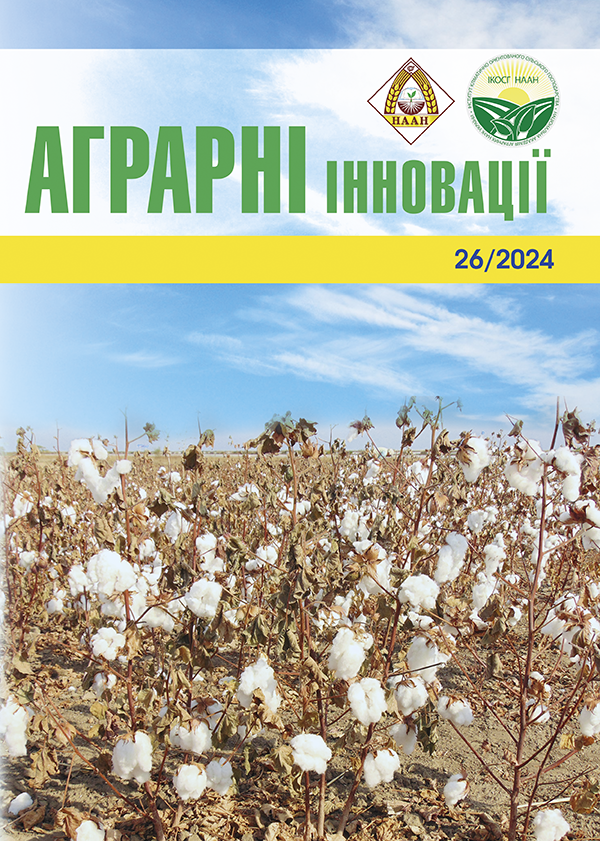THE GROWTH OF ABOVEGROUND MASS AND FORMATION OF YIELD OF WINTER WHEAT AND SPRING BARLEY IN THE SOUTH OF UKRAINE
Abstract
The purpose of the research was to conduct field experiments to determine the effectiveness of a complex of biological products on winter wheat crops and spring barley. Methods. Field and laboratory studies were performed in accordance with modern requirements and standards of research in agronomy and agriculture. Results. The use of modern biological products has helped to increase growth processes of winter wheat plants in all phases of growth and development. Higher winter wheat plants were in all phases of growth and development with compatible use in the technology of cultivation of Azotophyte and Helprost. Depending on the phase of growth and development of plants, on average during the years of research, their height was 21.2 – 86.3 cm. On average, during the years of research and in the growth and development of spring barley plants, the highest rates of linear plant size were noted for the use of nitrogen and chelprost – 73.2 cm. The absolute advantage in the formation of raw biomass plants of winter and spring barley in all phases of growth and development belonged to the variant with the use of a Azotophyte for pre -sowing seed treatment and Helprost – for foliar feeding of crops. The highest yield of winter wheat was formed for the use of Azotophyte and Helprost and was 6.17 t/ha, which has exceeded the control variant of the experiment by 8.8%. On average, during the years of research, the growth of spring grain yield from the use of Azotophyte and Helprost was 0.54 t/ha or 14.8%. Conclusions. In the conditions of the Southern Steppe of Ukraine, on average over the years of research, the use of pre-sowing treatment of winter wheat and spring barley seeds with the biological preparation Azotofit and foliar feeding twice during the growing season with the preparation Helprost ensures the formation of maximum linear dimensions and indicators of accumulation of fresh above-ground mass of plants. The highest yield of winter wheat and spring barley grain was formed by plants under this variant of the experiment – the increase compared to the control was 8.8% and 14.8%, respectively.
References
2. Molotoks A. S., Pete D. T. Impacts of land use, population, and climate change on global food security. Food and Energy Security. 2020. 10. 10.1002/fes3.261.
3. The formation of the productivity of winter wheat depends on the predecessor, doses of mineral fertilizers and bio preparations / Gamayunova V., Kovalenko O., Smirnova I., Korkhova M. Scientific Horizons. 2022. 25(6). 65-74. doi: 10.48077/scihor.25(6).2022.65-74
4. Panfilova A., Gamayunova V., Potryvaieva N. The impact of nutrition optimization on crop yield and grain quality of spring barley varieties (Hordeum vulgare l.). Agraarteadus. 2021. 32(1). 111–116.
5. Drobitko A., Kachanova T. Agroecological substantiation of technologies for growing grain crops in the conditions of the Southern Steppe of Ukraine. Ukrainian Black Sea Region Agrarian Science. 2023. 27(4). 9-17. doi: 10.56407/ bs.agrarian/4.2023.09.
6. Evaluation of three wheat species (Triticum aestivum L., T. spelta L., T. dicoccum (Schrank) Schuebl) commonly used in organic cropping systems, considering selected parameters of technological quality / Petrenko V., Spychaj R., Prysiazhniuk O., Sheiko T., Khudolii L. Romanian Agricultural Research. 2018. 35. 255-264.
7. Development of winter wheat productivity under the influence of biopreparations and different moisture conditions in the steppe zone / Panfilova A., Korkhova M., Domaratskiy Y., Kozlova O. Ecological Engineering and Environmental Technology. 2025. 26(3). 245–254.
8. Вожегова Р. А., Кривенко А. І. Вплив біопрепаратів на продуктивність пшениці озимої та економічно-енергетичну ефективність технології її вирощування в умовах Півдня України. Вісник аграрної науки Причорномор'я. 2019. Вип. 1 (101). С. 39-46. doi: 10.31521/2313-092X/2019-1(101)-6
9. Грабовська Т. О., Мельник Г. Г. Вплив біопрепаратів на продуктивність пшениці озимої за органічного виробництва. Агробіологія. 2017. № 1. С. 80–85.
10. Панфілова А. В. Наростання надземної маси та формування врожайності зерна пшениці озимої в умовах Південного Степу України. Аграрні інновації. 2023. № 17. С. 107 – 112.






